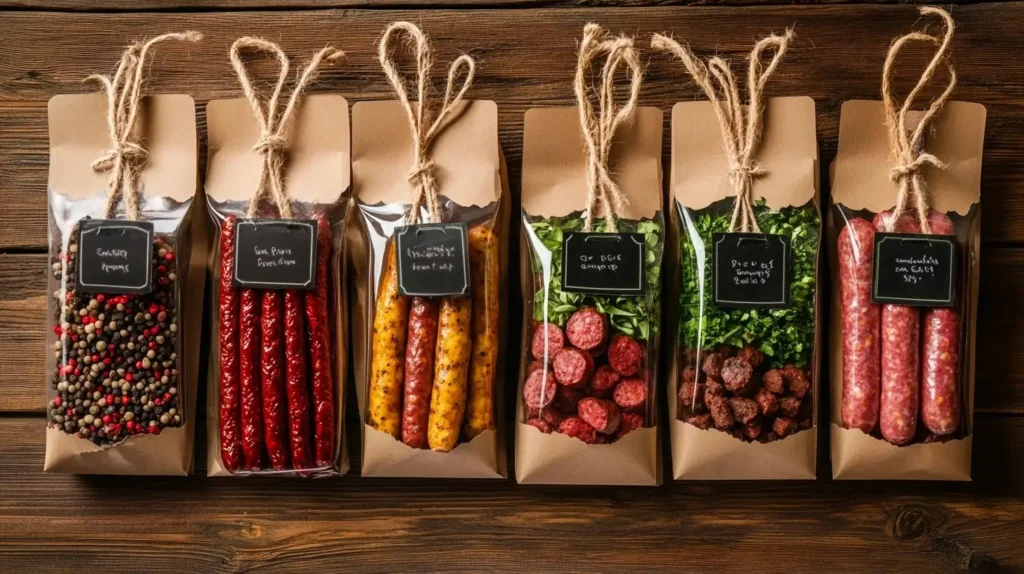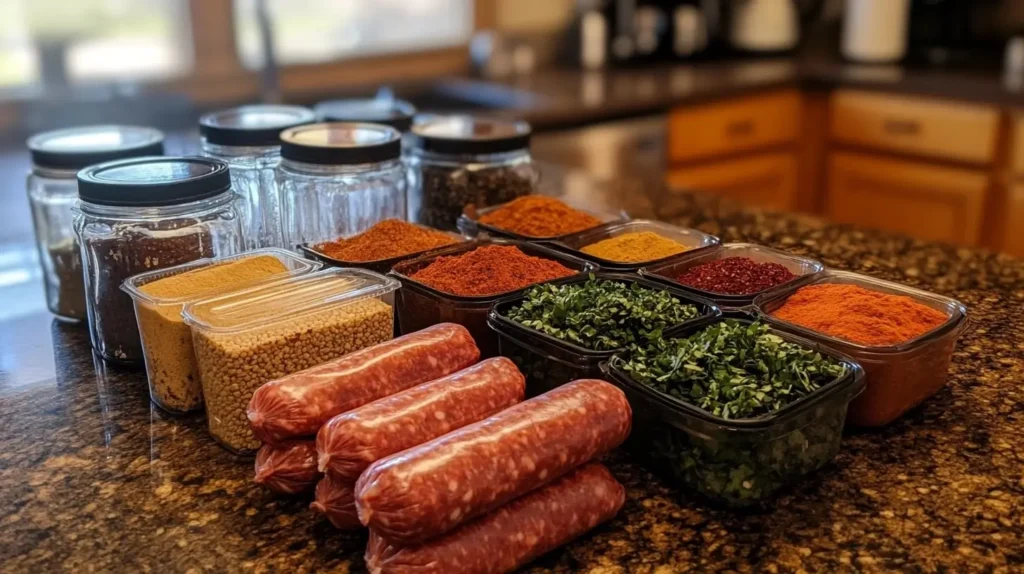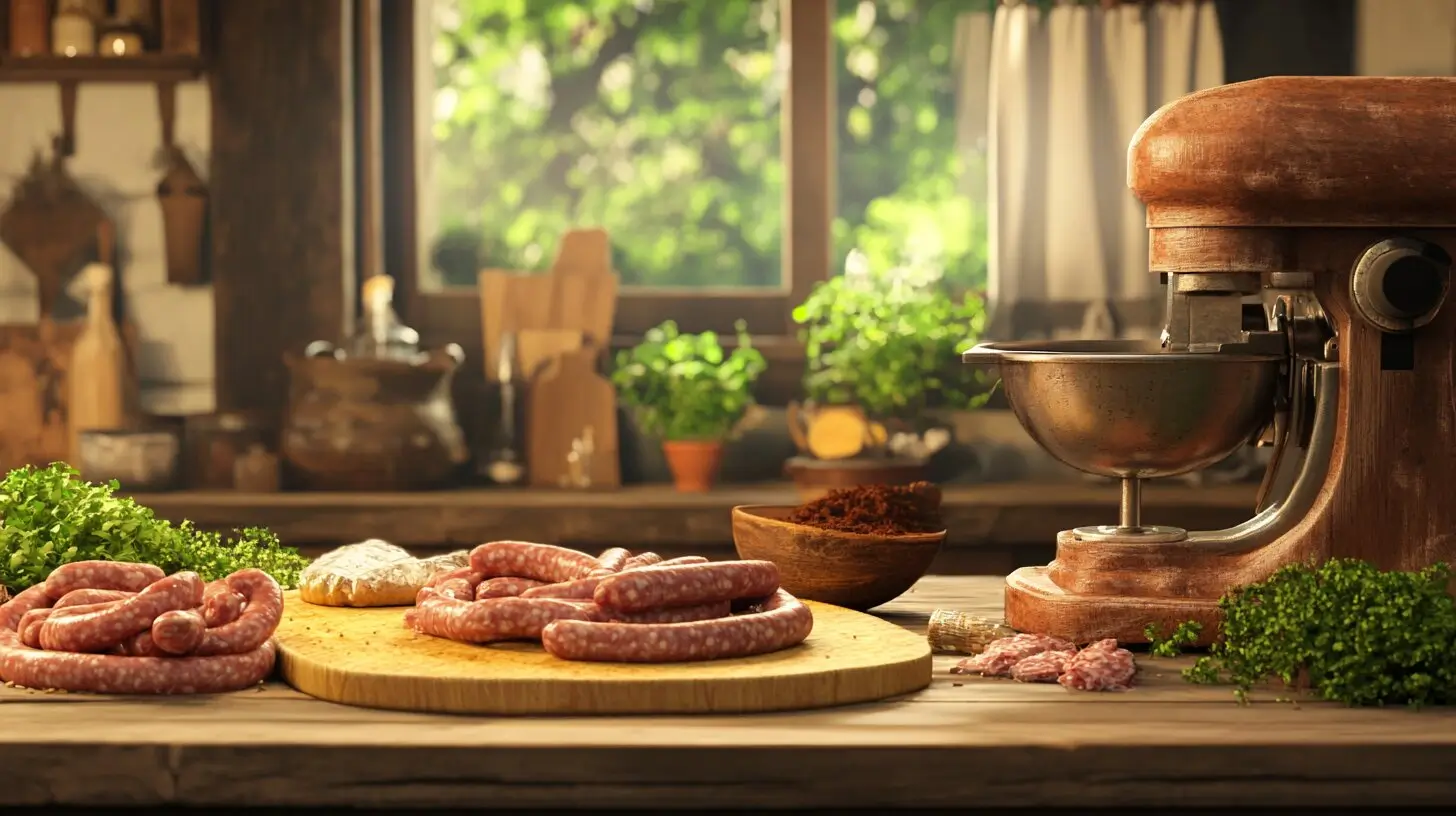Making your own sausage at home can be a rewarding and cost-effective choice, especially when compared to store-bought options. With rising interest in personalized and healthy cooking, like the inspiration from recipes for Easy & Irresistible Gluten And Dairy-Free Breakfast Ideas, homemade sausage-making offers not only financial benefits but also the flexibility to cater to dietary preferences. This guide delves into the financial, nutritional, and creative aspects of crafting your own sausages at home.
In this article, we’ll take a detailed look at the cost of sausage-making, comparing the expenses of homemade versus store-bought sausages. From ingredients and equipment to hidden costs and potential savings, we’ll break it all down so you can decide if this tasty DIY project is worth your time and money.
Table of contents
- Understanding Sausage-Making Costs
- Ingredients Cost Analysis
- Equipment Investment
- Time and Effort Considerations
- Comparing Store-Bought vs. Homemade Sausage
- Health and Nutritional Benefits
- Customization and Taste Advantages
- Bulk Making and Cost Efficiency
- Sustainability and Waste Reduction
- Hidden Costs of Sausage-Making
- Case Studies: Real-Life Comparisons
- Tips for Reducing Costs
- Frequently Asked Questions
- Conclusion
Understanding Sausage-Making Costs
When evaluating whether making your own sausage is cheaper, it’s important to understand the various costs involved. These include both upfront and recurring expenses, as well as factors that influence pricing over time. Let’s dive into the details.
Breakdown of Store-Bought Sausage Prices
Store-bought sausages come in a range of price points. Budget-friendly options can cost as little as $3–$5 per pound, while premium or artisanal varieties may exceed $10–$15 per pound. The price varies depending on factors like meat quality, flavor, and brand.
Although buying sausages at the store is convenient, it comes with certain trade-offs:
- Limited ingredient control: Many store-bought options include fillers, preservatives, or additives.
- Fluctuating prices: Market demand and production costs can impact prices.
- Lack of personalization: You’re confined to the flavors and recipes provided by manufacturers.
Key Factors Influencing Sausage-Making Expenses
- Meat Costs: The base ingredient for sausages is typically pork, beef, or chicken. Prices depend on the cut and type of meat chosen. For example, ground pork shoulder may cost $2–$3 per pound, while specialty meats like lamb or venison are more expensive.
- Spices and Herbs: Seasoning is essential for good sausages. While some spices (e.g., salt, pepper, garlic) are inexpensive and widely available, others like paprika or fennel seeds may add up.
- Casings: Sausage casings are another essential component. Natural casings (from hog or sheep intestines) often cost more than synthetic alternatives like collagen casings.
- Equipment Needs: The upfront cost of tools like grinders and stuffers can significantly impact the total expense, especially for beginners.
By carefully evaluating these factors, we can move closer to answering the question: is it cheaper to make your own sausage?
Ingredients Cost Analysis
The foundation of sausage-making lies in its ingredients. Understanding the costs of these components is crucial in determining if homemade sausages are more affordable than their store-bought counterparts.
Cost of Meat
The type of meat you use significantly impacts the overall cost of sausage-making. Here’s a breakdown of common choices:
- Pork: Often the go-to option, pork shoulder or butt is widely available and affordable, costing around $2–$4 per pound.
- Chicken: Leaner and versatile, chicken thighs or ground chicken range from $1.50–$3 per pound.
- Beef: More premium than pork or chicken, ground beef for sausages can cost $4–$7 per pound depending on the fat content.
- Game Meats: Specialty meats like venison or wild boar can cost upwards of $10 per pound but offer unique flavors for gourmet sausages.
Choosing cuts with a good balance of meat and fat is essential, as sausages require fat for juiciness and flavor.
Spices, Herbs, and Seasonings
Spices are the heart of any sausage recipe, but their costs vary widely:
- Basic Seasonings: Salt, pepper, and garlic are inexpensive staples and contribute to foundational flavor.
- Premium Spices: Ingredients like smoked paprika, coriander, or fennel seeds cost more, often around $5–$10 per small jar. However, a little goes a long way, as these are used in small quantities.
- Fresh Herbs: If you prefer fresh rosemary, thyme, or parsley, costs can range from $1–$4 per bundle. Growing your own herbs is a cost-effective alternative.
Casings
Sausage casings are a necessity, but there are budget-friendly options:
- Natural Casings: These cost around $10–$15 for a pack capable of making several pounds of sausage. They provide an authentic texture and are preferred by many for their snap and flavor.
- Collagen Casings: Synthetic casings are cheaper, ranging from $6–$10 per pack, and are easier to handle, making them a great choice for beginners.
Additional Ingredients
Adding extras like cheese, dried fruit, or specialty ingredients can elevate your sausage but will also increase costs. For instance:
- Cheese: A high-quality cheddar or gouda can add $5–$8 per pound.
- Dried Fruits or Nuts: Ingredients like cranberries or pistachios cost $4–$10 depending on the quantity.
Ingredient Cost Comparison
When making your own sausage, the cost per pound for basic recipes is generally $2–$4, depending on meat choice and seasonings. Gourmet recipes may increase this cost to $6–$8 per pound, which is still competitive with premium store-bought sausages.
Equipment Investment
Making your own sausage isn’t just about the ingredients; it also requires certain tools. While these represent an upfront cost, they are reusable and can save money in the long run if you make sausage frequently. But is it cheaper to make your own sausage when considering equipment costs? Let’s break it down.
Essential Tools for Beginners
For anyone starting out, a few basic tools are all you need to begin making sausages:
- Meat Grinder: A grinder processes raw meat into the desired consistency, a key step in making your own sausage.
- Manual grinders cost $25–$50 and work well for small batches.
- Electric grinders, priced at $100–$300, are more efficient for larger quantities, saving time and effort.
- Sausage Stuffer: This tool fills the casings, ensuring homemade sausages come together seamlessly.
- Hand-crank stuffers cost $30–$80.
- Stand mixer attachments, like those for KitchenAid, cost $50–$100 and offer multi-functionality.
- Mixing Bowls: Large bowls for blending meat and seasonings are inexpensive, typically $10–$20.
- Measuring Tools: Accurate measurements help ensure consistency in taste. A digital scale ($10–$30) and measuring spoons are highly recommended.
These basic tools make it much easier to answer the question: is it cheaper to make sausage at home compared to buying pre-packaged options.
Advanced Equipment for Enthusiasts
Once you’ve mastered the basics, investing in advanced equipment can improve your sausage-making experience:
- High-Quality Grinders: Heavy-duty grinders priced between $200–$500 process meat faster and last longer, making homemade sausages more efficient to produce.
- Vacuum Sealers: These preserve sausages for long-term storage, costing $50–$150 and helping you maintain the freshness of your homemade creations.
- Temperature Monitors: Essential for precision cooking and curing processes, starting at $20.
Ongoing Maintenance Costs
Even though most equipment is reusable, maintenance costs should be considered when asking is it cheaper to make your own sausage:
- Blade Sharpening: Grinder blades need periodic sharpening, which costs $10–$20.
- Replacement Parts: Grinder plates, stuffing tubes, or casings may require replacement over time, with prices depending on the brand and type.
Is the Investment Worth It?
The initial cost of equipment may seem high, but it pays off over time if you make sausage regularly. For example:
- An entry-level setup costs around $100–$150, which is equivalent to buying 15–20 pounds of premium store-bought sausage.
- For those who make larger batches or frequently experiment with flavors, the savings add up quickly, making it clear that making your own sausage can indeed be more cost-effective in the long run.
Time and Effort Considerations
While cost is a major factor in determining if making your own sausage is cheaper, it’s equally important to consider the time and effort involved. Sausage-making is a hands-on process that requires preparation, attention to detail, and some practice.
Time Required for Making Sausages
The amount of time you’ll need depends on the batch size and your experience level. Here’s an estimate:
- Preparation:
- Grinding meat and mixing seasonings: 20–30 minutes.
- Preparing casings (soaking natural casings or cutting synthetic ones): 15–20 minutes.
- Stuffing Sausages:
- Filling and twisting sausages: 30–60 minutes for a medium batch (5–10 pounds).
- Cleanup:
- Cleaning equipment and surfaces: 20–30 minutes.
Overall, making 10 pounds of sausage can take 1.5–2.5 hours, depending on your efficiency. Larger batches may take longer but offer better time efficiency per pound.
Skill Level and Learning Curve
Making sausages isn’t difficult, but it does have a learning curve:
- Beginners: Mistakes like overstuffed casings or uneven seasoning are common but improve with practice.
- Experienced Makers: Once you’ve mastered the technique, the process becomes smoother and quicker.
- Learning Resources: Online tutorials, recipe books, and classes can help you get started.
Batch Size Benefits
The effort required to make sausages is relatively consistent, regardless of batch size. This means:
- Larger batches save time per pound.
- Extra sausages can be frozen, making the effort worthwhile.
Is It Worth the Effort?
For those who enjoy cooking or value control over their food, sausage-making can be a rewarding activity. It’s an opportunity to create unique flavors and ensure quality. However, for individuals with limited time, the effort may outweigh the cost benefits.
Comparing Store-Bought vs. Homemade Sausage
To determine if making your own sausage is cheaper, we need a direct comparison between store-bought and homemade options. This includes not only the financial cost but also the value derived from quality, control, and other factors.

Per-Unit Cost Comparison
Let’s break down the approximate cost of both options:
- Store-Bought Sausage:
- Budget-friendly sausages: $3–$5 per pound.
- Premium or artisanal sausages: $10–$15 per pound.
- Homemade Sausage:
- Ingredients (meat, spices, casings): $2–$4 per pound for basic recipes.
- Equipment investment: Around $100–$200 upfront, spread over multiple uses.
- Premium homemade sausage (with gourmet ingredients): $6–$8 per pound.
While homemade sausage can match the cost of budget store-bought options, it often beats premium sausages in price. Over time, the savings grow as equipment costs are offset.
Quality and Ingredient Control
One of the key advantages of homemade sausage is the ability to control every aspect of the ingredients:
- Customizable Recipes: You can adjust flavors to suit your taste or dietary needs.
- Freshness: Homemade sausages use fresh meat and spices, ensuring better taste and nutritional value.
- No Additives or Fillers: Many store-bought options contain preservatives, artificial flavors, or cheap fillers like soy protein, which you can avoid by making your own.
Shelf-Life Differences
Store-bought sausages often contain preservatives to extend shelf life. Homemade sausages, while free of these additives, can be frozen to ensure they last:
- Fresh homemade sausage: 3–5 days in the refrigerator.
- Frozen homemade sausage: 2–3 months without significant loss of flavor.
This flexibility allows you to make large batches and store them for future use, reducing the need for frequent purchases.
Taste and Satisfaction
Homemade sausages often taste better due to the ability to customize seasonings and use fresh ingredients. The satisfaction of creating your own recipes can be a unique reward that store-bought options can’t provide.
Health and Nutritional Benefits
When considering is it cheaper to make your own sausage, health and nutritional benefits often tip the scales in favor of homemade options. Unlike store-bought sausages, which may contain questionable additives and fillers, making your own sausage allows you to control every ingredient, ensuring your food aligns with your dietary goals.
Control Over Additives and Preservatives
Store-bought sausages often include a variety of additives to enhance their appeal, such as:
- Preservatives: Sodium nitrite prolongs shelf life but may raise health concerns with frequent consumption.
- Fillers: Cheap fillers like soy protein or breadcrumbs lower production costs but compromise the quality of the sausage.
- Artificial Flavors and Colors: Common in mass-produced sausages to ensure consistency but detract from the natural flavor.
By making your own sausage, you eliminate these unwanted ingredients, producing a healthier and more natural product. For many, this health benefit alone answers the question: is it cheaper to make sausage at home when considering long-term health costs?
Customizing for Dietary Needs
Homemade sausages also offer unparalleled flexibility to cater to specific dietary needs:
- Low-Sodium Recipes: Control the salt levels to match your health requirements.
- Gluten-Free Sausages: Easily skip traditional fillers like breadcrumbs for a gluten-free option.
- Low-Fat Choices: Use leaner cuts of meat and add healthier fats like olive oil or avocado.
- Allergy-Friendly Sausages: Avoid allergens such as soy, nuts, or dairy entirely.
Such customization allows you to create a product that not only suits your taste but also meets your nutritional goals. This benefit is another reason people find making your own sausage worthwhile.
Organic and Fresh Ingredients
When you make your own sausage, you can prioritize high-quality, fresh, and organic ingredients:
- Organic Meat: Choose meat free from hormones and antibiotics, which are often present in conventional store-bought options.
- Fresh Herbs and Spices: Add unprocessed flavors like rosemary, thyme, or paprika to enhance taste naturally.
Homemade sausages let you know exactly what you’re eating, a level of control store-bought sausages simply cannot offer.
Nutritional Advantages
Homemade sausages also provide the opportunity to add healthier ingredients and boost nutritional value:
- Add Vegetables: Mix in spinach, zucchini, or mushrooms to pack in extra vitamins and fiber.
- Incorporate Omega-3 Fats: Use flaxseed, chia seeds, or walnut oil for heart-healthy fats.
- Lean Protein Alternatives: Swap traditional pork for turkey or chicken to reduce fat and calorie content.
This flexibility ensures that making sausage at home isn’t just cost-effective but also an investment in better health.
Conclusion on Health Benefits
When comparing store-bought sausages to homemade, the nutritional advantages of making your own sausage are undeniable. By using fresh, organic ingredients and eliminating harmful additives, you not only answer the question of is it cheaper to make your own sausage, but you also create a healthier, more personalized product. Homemade sausages are not just an economical choice—they’re a choice for better living.

Customization and Taste Advantages
One of the most exciting aspects of making your own sausage is the ability to experiment with flavors and ingredients. Unlike store-bought sausages, which are limited to the recipes and styles offered by manufacturers, homemade options open the door to endless possibilities.
Ability to Create Unique Flavors
When you make your own sausage, you’re in control of every ingredient. This means you can create flavors tailored to your preferences or inspired by your favorite cuisines:
- Sweet Sausages: Add ingredients like maple syrup, honey, or dried fruits.
- Spicy Varieties: Use chili flakes, cayenne pepper, or jalapeños to turn up the heat.
- Herbal Blends: Experiment with rosemary, sage, or thyme for earthy undertones.
Exploring Cultural and Regional Recipes
Homemade sausage-making is an opportunity to delve into culinary traditions from around the world:
- Italian Sausages: Featuring garlic, fennel, and parsley.
- German Bratwurst: Made with pork and spiced with nutmeg and caraway.
- Spanish Chorizo: Highlighting smoked paprika and garlic.
- Asian-Inspired Sausages: Using lemongrass, soy sauce, or ginger for a unique twist.
By recreating traditional recipes or blending elements from multiple cuisines, you can craft sausages that reflect your culinary creativity.
Family-Friendly Options
Homemade sausages also allow you to cater to the tastes and dietary needs of your family:
- Kid-Friendly Sausages: Use milder spices and add cheese or sweet ingredients.
- Health-Conscious Options: Focus on lean meats and minimal seasoning for a natural flavor.
- Vegetarian Alternatives: Experiment with plant-based proteins like tofu, lentils, or mushrooms for vegetarian sausage recipes.
Taste Benefits
Homemade sausages generally have a fresher, more robust flavor because you can control the quality of your ingredients. Store-bought sausages, on the other hand, often rely on artificial flavors or high levels of sodium to enhance taste.
The Fun Factor
Sausage-making isn’t just about saving money or improving quality—it’s also a fun activity. It’s a chance to engage with friends or family in a creative culinary project, making the process as enjoyable as the end result.
Bulk Making and Cost Efficiency
Economies of Scale in Sausage-Making
Making sausages in larger batches reduces the cost per pound. By buying ingredients in bulk and using your equipment efficiently, you save money while preparing enough sausage to last weeks or months.
Freezing and Storing Homemade Sausages
Homemade sausages freeze well, retaining their quality for 2–3 months. Proper storage in vacuum-sealed bags ensures minimal waste and convenience for future meals.
Sustainability and Waste Reduction
Reducing Packaging Waste
Homemade sausage eliminates the need for single-use packaging often found with store-bought options, reducing environmental impact.
Using Meat Scraps Effectively
Sausage-making allows you to use leftover meat cuts, preventing waste and making the process more economical.
Ethical Sourcing Considerations
By sourcing meat from ethical farms, you can ensure animal welfare and environmental sustainability.
Hidden Costs of Sausage-Making
Potential for Wastage During the Learning Phase
Beginners may encounter issues like torn casings or poorly balanced seasoning, leading to some wastage.
Storage and Energy Costs
Freezing sausages requires adequate storage space and energy, which adds minor ongoing costs.
Case Studies: Real-Life Comparisons
Cost Analysis from Homemade Enthusiasts
Homemade sausage enthusiasts report saving $2–$5 per pound compared to premium store-bought options.
Example Budgets and Savings Breakdowns
For example, making 10 pounds of pork sausage at $3/lb, compared to buying premium sausage at $10/lb, saves approximately $70 in one batch.
Tips for Reducing Costs
- Buying Ingredients in Bulk: Wholesale meat and spices lower costs significantly.
- Utilizing Seasonal Sales: Stock up on meat during holiday or seasonal discounts.
- Sharing Equipment and Recipes: Collaborate with friends to split costs for tools and share innovative recipes.
Frequently Asked Questions
Can Sausage-Making Be Done Without Special Tools?
Yes, with a simple grinder attachment or manual stuffer, you can start with minimal investment.
How Long Does Homemade Sausage Last?
Refrigerated sausage lasts 3–5 days; frozen sausage can stay fresh for up to 3 months.
Is Homemade Sausage Healthier Than Store-Bought?
Yes, homemade options exclude preservatives, fillers, and excessive sodium, making them healthier overall.
Conclusion
Making your own sausage can be a cost-effective, sustainable, and rewarding experience. While it involves upfront investments and some effort, the benefits of customization, quality, and long-term savings outweigh the costs. Whether you’re seeking unique flavors, healthier options, or simply a fun DIY project, homemade sausages deliver on all fronts.
You may also like
If you love traditional German cuisine, don’t miss The Perfect Matjesbrötchen Recipe. It pairs wonderfully with Can You Fry Rockfish? A Complete Guide or try it alongside San Antonio Grilled Mexican Chicken Marinade for a seafood-meets-grill experience.

